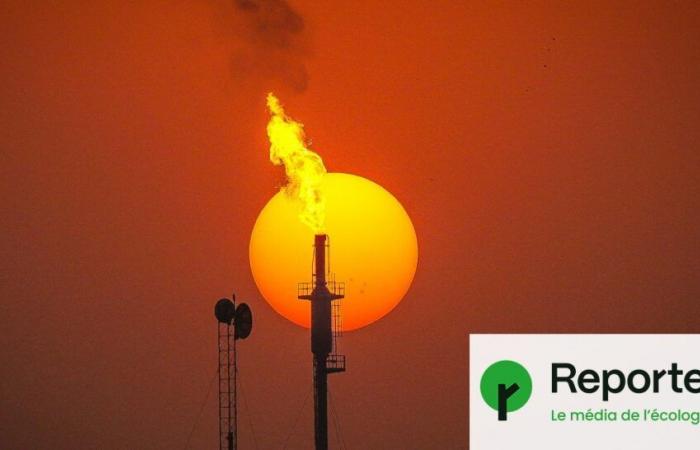We are still not on the right trajectory. According to the latest projections from the Global Carbon Project – a collective bringing together 120 scientists around the world – global emissions of CO2 linked to the production and consumption of fossil fuels continue to grow. In a report published Wednesday, November 13, researchers estimate that in 2024 these emissions will increase by 0.8 % compared to last year. Or 37.4 billion tonnes of carbon dioxide (GtCO2) sent into the atmosphere.
In addition to fossil fuels, land use change (mainly deforestation) emitted 4.2 GtCO2. A figure up slightly compared to 2023 (4.1 GtCO2). In question, « drought during the El Niño phenomenon and deforestation led to numerous fires in Brazil and Indonesia this year »say the researchers. All-inclusive, emissions estimates CO2 reach 41.6 billion tonnes in 2024 compared to 40.6 billion tonnes last year.
« It is clear that the remaining carbon budget is almost exhausted »
Is it too late to respect the Paris Agreement and limit global warming to 1.5°C compared to the pre-industrial era (1850-1900) ? At the current rate, there are 50 % chance that warming will exceed 1.5°C consistently over several years within about six years, according to scientists at the Global Carbon Project. If this estimate is subject to large uncertainties linked to additional warming caused by other agents which are also warming (CH₄, N₂O, aerosols) « it is clear that the remaining carbon budget – and therefore the time left to reach the 1.5°C target – is almost exhausted ». If we continue at the same pace, « +2°C will be reached in twenty-seven years ».
All fossil emissions are on the rise
For a single year, the bar has already been crossed, the Copernicus Institute announced in early November. The European observatory has indicated that it is now « almost certain » that the year 2024 will be the hottest on record, with an average temperature 1.6°C higher than the average temperature of the pre-industrial era.
Despite the urgency, researchers at the Global Carbon Project say there is still no « no sign » that the world has reached a peak in emissions of CO2. Two days after the opening of the COP29 in Baku, Azerbaijan, they call on leaders to « make commitments to quickly and sharply reduce fossil fuel emissions to give us a chance of staying below 2°C above pre-industrial levels ».
In detail, emissions linked to natural gas would jump in 2024 by 2.4 %, those relating to oil would be up by 0.9 % and those linked to coal are expected to grow by 0.2 %. Only emissions linked to cement are decreasing (-2.8 %), due to the construction crisis in China and the United States. However, « given the uncertainty of the projections, it is possible that emissions from coal – the most harmful fuel for the atmosphere – will decrease in 2024 »specify the scientists in the report.
In India and China, increases less strong than in 2023
Not all countries are on the same trajectories. On the bad side, India, responsible for 8 % of global emissions CO2is still on an upward slope. After an increase of 8.2 % in 2023, its emissions of CO2 increase this year « only » of 4.6 %.
China, which emits almost a third of global emissions (31 %), does not change the trend but its emissions increase much less than before: 4.9 % in 2023 against 0.2 % This year. « Demand for electricity continues to grow strongly, both in industry and in households, coal consumption has increased slightly »note scientists from the Global Carbon Project.
« Demand for electricity continues to grow strongly »
Moreover, « emissions from oil have probably peaked, electric vehicles are steadily gaining market share ». For information, China has committed to achieving carbon neutrality in 2060 and peak emissions in 2030.
More modest declines in the United States and the European Union
The United States, for its part, continues its decline in carbon emissions. CO2. After a decrease of 3 % in 2023, this year, carbon dioxide emissions are expected to decline by 0.6 %. This decline concerns both coal – abandoned in favor of natural gas – oil and cement. While the country has committed to achieving carbon neutrality by 2050, the election of Donald Trump as president could change that.
If the European Union once again shows the largest drop in emissions, -3.8 % of CO2 in one year, according to researchers' estimates, it is much less than in 2023 (-7 %). For what ? Part of it can be explained by the energy crisis in 2023, scientists respond: « The fall was very sharp in 2023 because Europeans were less heated than usual due to the rise in electricity prices following the cessation of Russian gas imports. » In addition, the winter of 2023 had been particularly mild.
For the « rest of the world » (i.e. all other countries excluding China, the United States, India and those in the European Union), emissions are up by 1.1 %.
Concerning the different emissions sectors, international aviation and maritime transport, responsible for 3 % of global emissions, are expected to increase by 13.5 respectively % et 2,7 % in 2024.
Technology will not save the climate
If we look at ten-year trends, however, researchers observe a slowdown in the increase in carbon emissions. CO2. Between 2013 and 2024, they were +0.6 % per year on average, compared to +2.4 % during the previous decade.
And we must not rely on technology to save the climate. « Current levels of carbon dioxide removal through technology (carbon capture and storage CO2) only make it possible to compensate one millionth of the CO2 emitted by fossil fuels »remind the scientists.
In addition to reducing coal, oil and gas activities, we must take greater care of oceanic and terrestrial carbon sinks. These save us from the worst by absorbing half of the total emissions of CO2 over the last decade despite the negative effects of climate change on these ecosystems.
Finally, if the effects of the El Niño episode led to a sharp reduction in carbon sinks in 2023, for example by promoting droughts, these carbon sinks should re-establish with the end of this weather phenomenon, scientists predict.
legend






